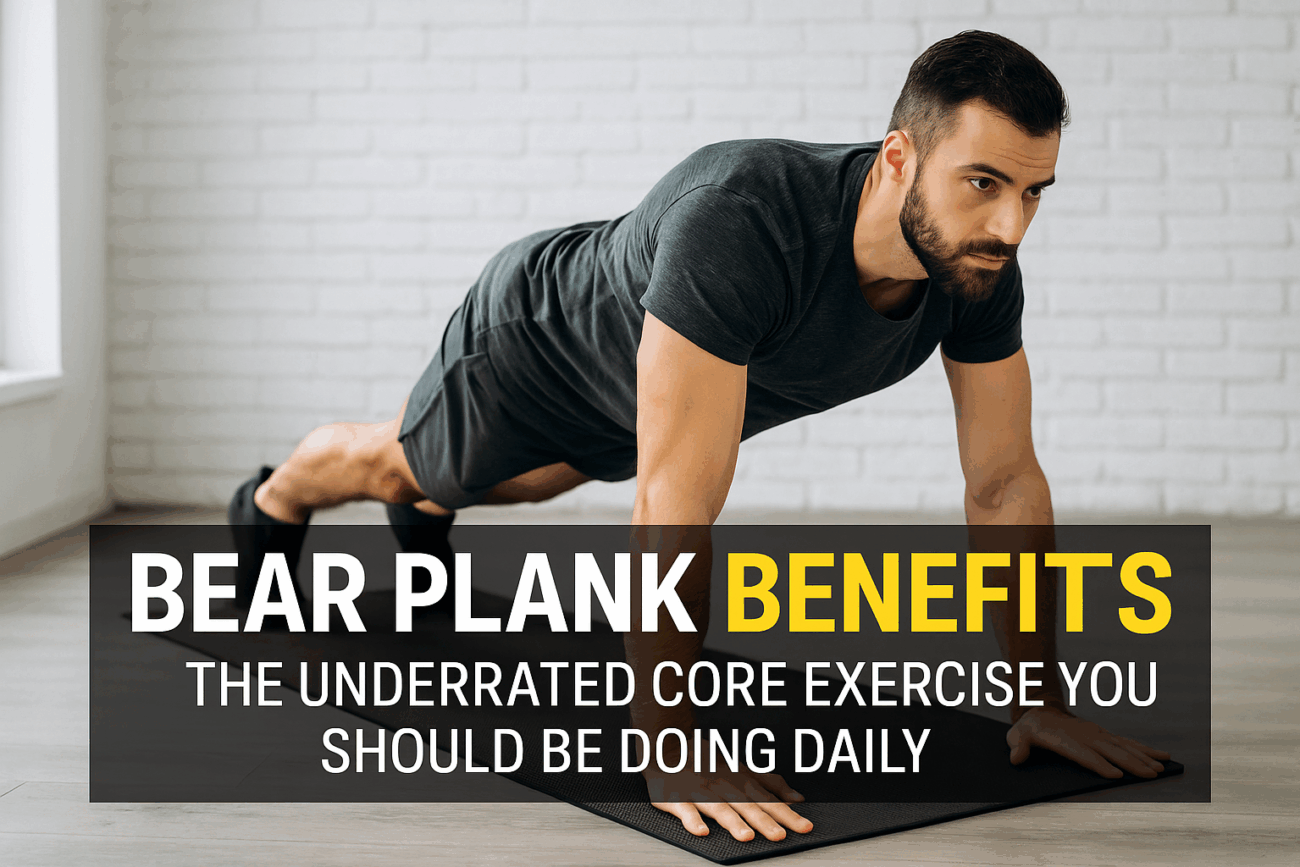Introduction: Why the Bear Plank Might Be the Best Core Move You’re Not Doing
Tired of crunches that hurt your neck but barely work your abs? You’re not alone.
Many people think sit-ups are the key to a strong core. But they often cause pain and don’t train your body the way it moves in daily life. That’s where the bear plank shines.
This simple yet powerful move is one of the most effective core strengthening exercises available. It targets your abs, glutes, and shoulders—all without straining your back. Whether you’re a beginner or a fitness pro, this is a functional ab exercise that deserves a permanent spot in your workout routine.
In this article, you’ll learn:
- What the bear plank is and how to do it properly
- Why it’s the best plank variation for real-world strength
- Top benefits of bear plank training
- Easy progressions and weekly routines
Let’s dive into one of the most underrated bodyweight core workouts you can do anytime, anywhere.
I. What Is a Bear Plank and How Is It Different from a Standard Plank?
This is a dynamic, tabletop-style exercise that trains your entire core. You start on your hands and knees, then lift your knees a few inches off the floor while keeping your back flat and abs tight.
How this Stands Out:
- Knees bent and hovering – creates constant core tension
- Safer on the spine – unlike crunches or long forearm planks
- Targets multiple muscle groups – making it one of the top core stability workouts
II. Benefits of Bear Plank: Why It Works
This looks simple, but the results are powerful:
- Core Strength: Activates deep muscles like the transverse abdominis and obliques
- Spinal Health: Builds strength without the flexion of traditional crunches
- Full-Body Stability: Works shoulders, hips, and glutes while keeping your core tight
- Posture Support: Strengthens muscles responsible for holding you upright
- Injury Prevention: Boosts balance, control, and overall coordination
📚 According to ACE Fitness and NSCA, this exercise delivers high muscle activation with low spinal load—making it one of the safest core strengthening exercises available.
III. Bear Plank vs Forearm Plank: Which Builds a Stronger Core?
Here’s a quick comparison to help you choose:
| Exercise | Core Strength | Back Safety | Shoulder Load | Beginner-Friendly |
|---|---|---|---|---|
| Bear Plank | ✅✅✅ | ✅✅✅ | ✅✅ | ✅✅✅ |
| Forearm Plank | ✅✅ | ✅✅ | ✅✅✅ | ✅✅ |
| High Plank | ✅✅ | ❌ | ✅✅✅ | ✅✅ |
| Side Plank | ✅✅✅ | ✅✅ | ✅ | ❌ |
✅ This wins for full-body control and safe core engagement—especially for daily use.
IV. How to Do it With Perfect Form
Want to master the bear plank for beginners? Follow these steps:
How to Do it:
- Start in tabletop: hands under shoulders, knees under hips
- Tuck toes and lift knees 1–2 inches off the floor
- Brace your core and keep your back flat
- Hold for 10–30 seconds while breathing normally
Avoid These Mistakes:
- Don’t let hips rise or sag
- Keep knees directly under hips
- Avoid sinking into your shoulders
- Don’t hold your breath
✅ Tip: Use a mirror or video yourself to check your form.
V. Variations to Progress Your Core Training
Once you’ve nailed the basic form, try these progressions:
- Shoulder Taps – Tap each shoulder without rotating
- Bear Crawl Hold – Step knees forward slightly and hold
- Down Dog – Alternate for mobility and core strength
- Leg Lifts – Lift one leg at a time while maintaining form
- Marching – Move limbs one at a time without shifting hips
- Resistance Band – Add a band around thighs or wrists for extra challenge
These upgrades are one of the most adaptable bodyweight core workouts out there.
VI. Weekly Core Stability Workout with Bear Plank
Start small and build up with this beginner-friendly plan:
| Day | Focus |
| Day 1 | 3 sets of 10-second bear planks |
| Day 2 | Rest or light walk |
| Day 3 | 3 sets of bear plank shoulder taps |
| Day 4 | Add leg lifts (2 sets of 8 per leg) |
| Day 5 | Bear plank + glute bridges |
| Day 6 | 30-second hold after a full workout |
| Day 7 | Recovery or mobility work (yoga, stretch) |
✅ This simple plan delivers serious core results in under 10 minutes a day.
VII. Why Bear Planks Are Better Than Crunches
Tired of neck pain or endless crunches that don’t deliver? Switch to this.
Crunches:
- Can strain your neck or lower back
- Only target surface-level muscles
- Don’t build real-world strength
Bear plank:
- Trains deep core and spinal stability
- Builds posture and full-body control
- Functions better for everyday movements
✅ If you want abs without crunches, bear plank is the smarter choice.
Conclusion: Why the Bear Plank Belongs in Your Routine
Simple. Scalable. Effective. The bear plank is one of the most powerful functional ab exercises you can do.
It builds deep strength, supports good posture, and works your entire body—all without equipment or complex programming. Whether you’re doing a core stability workout or just adding one move to your routine, this is the one.
Start today. Hold a 10-second bear plank. Feel your core switch on. Then build from there. Your stronger, more stable body begins now.
Read more about: Stretching: Stretching Basics, Common Reliefs and Beginners Stretch
How to Start Exercising
Fitness Routine
12 Proven Health Benefits of Good Posture
ACE Fitness – Core Stability and Bear Plank Technique
National Strength and Conditioning Association (NSCA)
https://www.healthline.com/health/14-plank-variations-your-core-will-thank-you-for-laterHealthline – Planks Exercises

